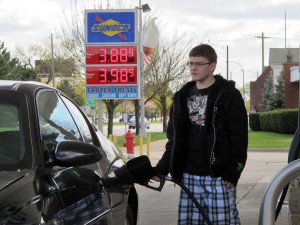A combination of changing demographics, greater fuel efficiency and wider use of alternative energy sources is expected to reduce the amount of energy Americans consume for transportation over the next quarter century.
A new survey by the U.S. Energy Information Administration indicates the long-term fuel needs for cars, trucks, airplanes, boats, and rail will steadily decline through 2040.
Transportation energy, including energy demand from light-duty vehicles, heavy-duty vehicles, aircraft, marine vessels, rail and other sources, reached 13.8 million barrels per day in 2012 or 28% of all energy consumption in the United States. But that was down from a peak of 14.6 million barrels per day in 2007.
The EIA’s Annual Energy Outlook for 2014 indicates that light duty vehicle energy consumption made up 63% of all transportation needs in 2012, but its share is projected to drop to 51% by 2040.
A key factor is the aging of the driving population over the course of the projection, which will result in a significantly lower level of vehicle miles traveled, or VMTs, after 2018, the EIA said.
(Pickups lose momentum as sales of plug-based vehicles get charged up. Click Here for the latest.)
Earlier forecasts had projected that the number would climb 41% from 2012 to 2040. But the new EIA forecast trims that to a more modest 30% increase in vehicle miles traveled during the same period.
Improved fuel economy is certainly a factor. By 2025, the U.S. will see an increase in the Corporate Average Fuel Economy standard to 54.5 miles per gallon. But the EIA also points to a number of demographic trends, such as an aging population and decreasing rates of licensing and travel among younger age groups. Trends in employment and income also were considered in the forecast.
The study points to a number of other shifts underway, such as the increasing use of liquid natural gas as a fuel for freight rail locomotives and domestic marine vessels such as river barges. Natural gas is predicted to account for 35% of freight rail energy consumption in 2040.
In addition, the use battery-electric vehicles, hybrid-electric and plug-in-electric vehicles will increase thanks to wider product availability and expected improvements in electric drive efficiency that will make EVs more acceptable to the general public, the EIA suggests.
(Despite skeptics, fuel-cell vehicles hit the market. Click Herefor more.)
Fuel prices are expected to have a long-term impact on both the type of vehicles American motorists will drive, and how much time they will spend behind the wheel.
There have been numerous forecasts anticipating American gas prices would begin to rise to European levels but despite reaching the $4 level several times, the numbers haven’t come close to those levels. If and when that might happen remains to be seen.
For now, gasoline prices remain remarkably stable despite the advent of new crises in the Ukraine and Middle East and tensions in the South China Sea. In the past, global tensions would have been enough to send prices soaring.
(Automakers are charged up about fuel-saving turbo engines. Click Hereto find out why.)
Gasoline prices actually dropped across the United States last week, according to Gas Buddy Com, falling by roughly 4 cents per gallon. Gasoline prices have dropped, on average about 11 cent per gallon, over the past month and the price of crude oil has dropped to under $100 per barrel even as demand for gasoline continues to rise in China.
Another factor that could impact pricing – and long-term energy demands will be the availability of gasoline and its alternatives. Dire predictions that the world is rapidly reaching peak oil production levels have not been born out, with a number of recent discoveries suggesting there’s significantly more petroleum left to be tapped.
But how much more remains to be seen, and environmentalists content that even if oil is available, the growing concerns about global warming should force motorists and other energy consumers to rein back their usage.
(Paul A. Eisenstein contributed to this report.)

